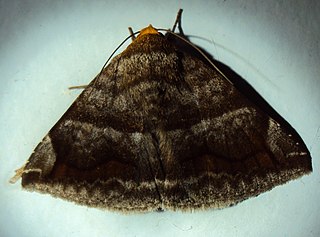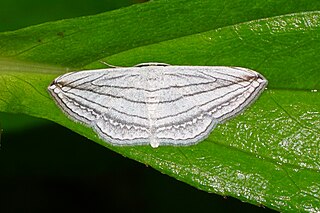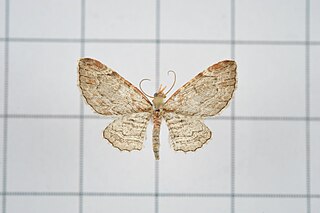
Dordura is a monotypic moth genus of the family Noctuidae erected by Frederic Moore in 1882. Its only species, Dordura aliena, was first described by Francis Walker in 1865. It is found in the Indian subregion, Sri Lanka, Myanmar, Thailand, Peninsular Malaysia, Sumatra, Borneo and New Guinea.

Psimada is a monotypic moth genus of the family Noctuidae. Its only species, Psimada quadripennis, is found in the Indian subregion, southern China, Taiwan, Myanmar, Thailand, Sri Lanka, the Andaman Islands, Sundaland, Sulawesi and Seram. Both the genus and species were first described by Francis Walker in 1858.

Hulodes caranea is a species of moth of the family Erebidae first described by Pieter Cramer in 1780. It is found from India, Sri Lanka, Myanmar, Java, Hong Kong to Queensland and New Guinea, it is also found on the Marianas and Carolines.

Buzara onelia is a moth of the family Erebidae. It is found from the Indian subregion to Sri Lanka, Myanmar, Sundaland, the Philippines and Japan.

Buzara umbrosa is a moth of the family Erebidae. It is found in China, India and Sri Lanka.

Probithia exclusa is a moth of the family Geometridae. It is found in the north-eastern Himalaya, Sri Lanka, the Philippines, Sulawesi and Sundaland.

Mnesiloba dentifascia is a moth of the family Geometridae first described by George Hampson in 1891. It is known from the Oriental tropics.

Gesonia obeditalis is a species of moth of the family Noctuidae first described by Francis Walker in 1859. It is found from eastern Africa, the Seychelles, the Maldives and the Oriental tropics of India, Sri Lanka east to the Philippines, the Sula Islands and Australia. The adult moth has brown wings with a scalloped dark brown band near the margin. The hindwings are similar in pattern to the forewings but are a paler shade of brown.

Somera viridifusca, the prominent moth, is a moth of the family Notodontidae described by Francis Walker in 1855. It is found in Sri Lanka, Sundaland, the Philippines, Sulawesi, the north-eastern Himalayas, Sikkim in India, Hainan and Yunnan in China and in Taiwan.

Scopula opicata is a moth of the family Geometridae first described by Johan Christian Fabricius in 1798. It is found in tropical Africa, including Malawi and Zambia, as well as in Sri Lanka, India, China (Hainan), Myanmar, Sundaland, the Philippines, Sulawesi, Timor and New Guinea.

Eupithecia costalis is a moth in the family Geometridae first described by Francis Walker in 1863. It is widespread in the tropical and subtropical lowland regions of east and south-east Asia, from Taiwan to India, Sri Lanka Borneo, Borneo, to Hong Kong.
Eriopithex recensitaria is a moth in the family Geometridae first described by Francis Walker in 1862. It is found in Sri Lanka, Taiwan, on Borneo and in the Australian state of Queensland.
Gymnoscelis deleta is a moth in the family Geometridae. It is found in India, Korea, Japan, Taiwan and probably in Sri Lanka according to Hampson.
Carbia pulchrilinea is a moth in the family Geometridae. The species was first described by Francis Walker in 1866. It is found in the Indian subregion, Sri Lanka and New Guinea, as well as on Borneo, the Mentawai Islands and the Bismarck Archipelago. The species is found from lowlands to the upper montane forest zone.
Racotis boarmiaria is a species of moth of the family Geometridae described by Achille Guenée in 1857. It is found in India, Sri Lanka, Maldives, Myanmar, China, Japan, Taiwan, Indonesia, Bhutan and Malaysia.

Hypopyra vespertilio is a moth of the family Erebidae first described by Johan Christian Fabricius in 1787. It is found in China, Korea, Honshu in Japan, India, Sri Lanka, Nepal, Thailand, Myanmar, Cambodia, Vietnam, Taiwan, Malaysia, the Philippines, Java, Sumatra and Sulawesi.
Streptoperas luteata is a moth in the family Drepanidae. It was described by George Hampson in 1895. It is found in the north-eastern Himalayas and on Borneo, Sumatra, Java, Bali and Sulawesi.
Eupterote testacea is a moth in the family Eupterotidae. It was described by Francis Walker in 1855. It is found in India and Myanmar.
Eupterote acesta is a moth in the family Eupterotidae. It was described by Charles Swinhoe in 1894. It is found in Thailand and India.
Eupterote nigriceps is a moth in the family Eupterotidae. It was described by George Hampson in 1893. It is found in Sri Lanka.










